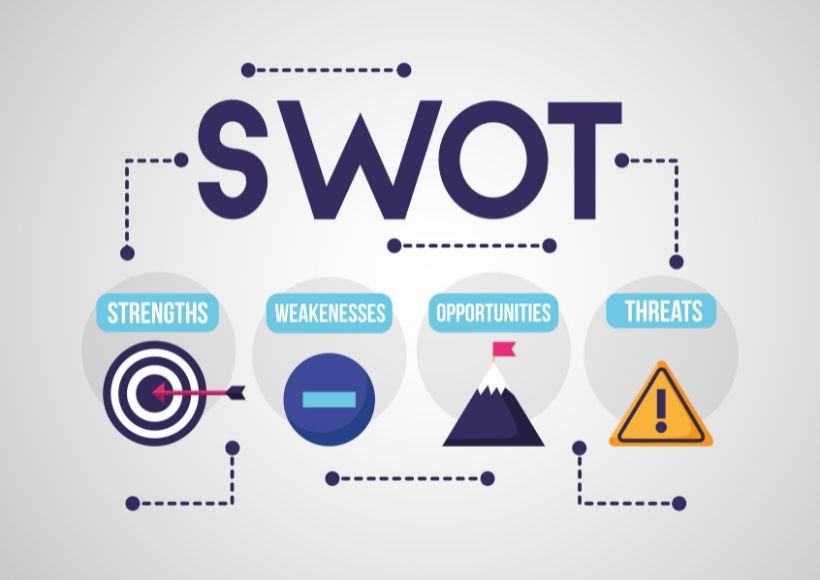What Is SWOT And How To Use SWOT Analysis To Solve Problems

SWOT analysis is the most frequently used technique to evaluate the factors influencing an organization’s success. Not only is it graphically explicit, but it is essentially very concise and, at the same time, comprehensive.
Table of Contents
How to create a SWOT analysis
SWOT analysis is most often used as a situational analysis for strategic planning. With its help, you will assess the company’s prerequisites for implementing strategies on the market.
However, it does not have to be only about preparing the company’s strategy. As such, SWOT analysis can also be used for sub-projects and new products or services.
The independent abbreviation SWOT is derived from the English names of the groups into which individual factors are classified. For clarity, matrices or graphs are used.
- S – strengths – strong sides
- W – weaknesses – weak sides
- O – opportunities – opportunities
- T – threats – threats
In general, strengths and weaknesses can be defined as factors from the company’s internal environment that can change or influence them. Opportunities and threats (external environment) cannot be influenced too much. However, we can consider them when preparing strategic plans and adapting to them.
SWOT analysis can be divided into several consecutive steps:
- Finding the factors
- Compilation of the SWOT matrix
- Evaluation
- Establishing a strategy/plan
Although several steps must be taken to complete a SWOT analysis, no clearly defined rules exist. It’s about forcing you to think about the elemental components of your business.
Finding factors
When searching for factors and classifying them, involving the whole team or at least its vital members is exemplary. This will allow you to look at the organization as a whole, and at the same time, you will have a better perception of its environment.
Through a collective form of cooperation, you specify more precisely the factors for individual quadrants (strengths and weaknesses, opportunities and threats), while you may also discover some new ones. It is also an excellent opportunity to start your creative thinking. You should find at least five items for each quadrant. Be critical and choose factors that are specific and relevant.
Of course, you can go deeper and use further detailed analysis with each quadrant. Which one you choose is up to you.
Other types of analysis:
- Porter’s analysis 5F – competitive environment
- McKinsey’s 7S model – suitable for strengths and weaknesses
- PEST (PESTLE) analysis – the impact of the macro environment, a source of information for opportunities and threats
- Porter’s Value Chain – Strengths and Weaknesses
As soon as you put the individual items into a matrix, you will start to see how they interact with each other. These interactions will serve as a hint when choosing a strategy.
Choosing a strategy
The last step is choosing the optimal strategy. How to take advantage of strengths, improve weaknesses, prepare for possible threats, and take advantage of opportunities.
When choosing a SWOT strategy, you are looking for interaction between the quadrants:
- SO – Offensive Strategy – Exploiting opportunities using strengths.
- ST – Defensive Strategy – Minimizing threats using strengths.
- WO – Alliance Strategy – Taking advantage of opportunities to eliminate or reconcile weaknesses.
- WT – Evasion/Removal Strategy – Minimizing the impact of threats on a vulnerable business.
Among the sought-after interactions, the most common are those that combine strengths with opportunities. These interactions lead to market expansion, new products, or better services. Other interactions that can be observed are between weaknesses and threats, from which emerge, for example, crisis plans.
Furthermore, it uses strengths to fight threats, such as an aggressive strategy against the competition. However, it is also possible to work with weaknesses and opportunities, for example, choosing a reliable ally.
Summary
SWOT analysis is a handy tool that makes sense to use only if further steps and fundamental changes will follow it. Of course, you can go into detail in each part, but that loses the main advantage of SWOT – brevity and clarity. As mentioned above, this tool should jump-start your creative thinking and show you where to go. That’s why we recommend: Giving your business a system.
Also Read : How To Create or Design The Secret Of a Successful Logo
